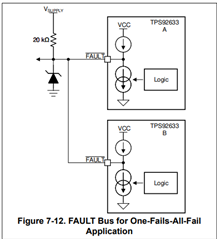Other Parts Discussed in Thread: TPS92633-Q1, TPS92633
Team,
Do you have detail on the calculation required to seize the pull up of on the fault pin of 'n' number of TPS92610-Q1 attached together to create a "one-fails–all-fail" bus ?
I guess you have to use the specs of the datasheet somehow but how exactly?
Olivier


